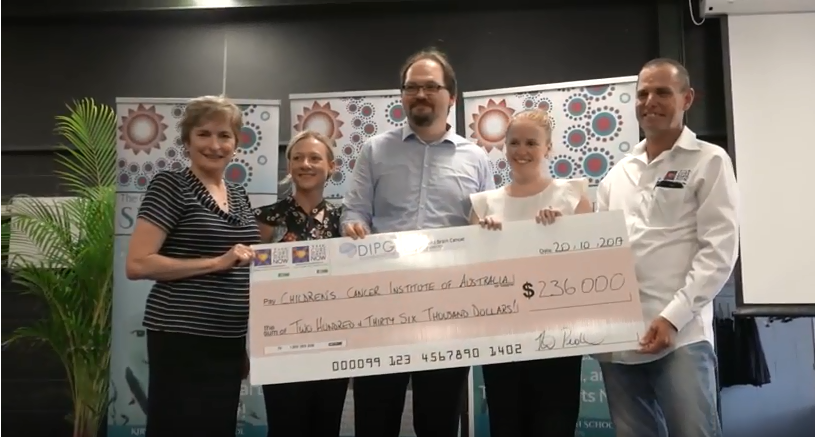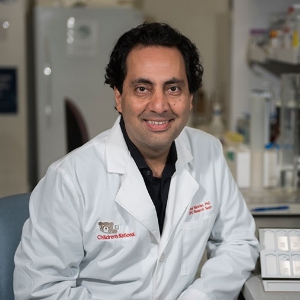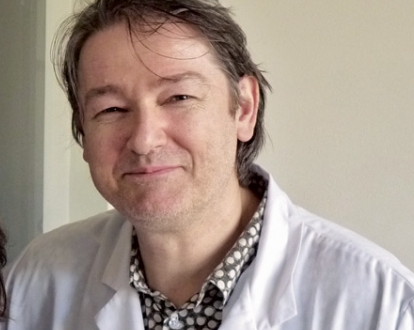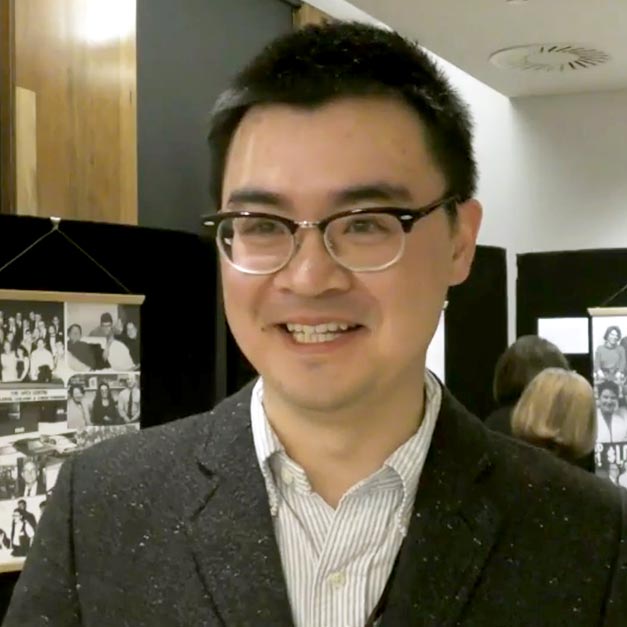Grants
The DIPG / DMG Collaborative has funded $19,422,550 in DIPG/DMG research.
Interested in applying for a grant from the DIPG / DMG Collaborative? Learn more.

Stanford University - $200,000
$200,000.00
October 2017
Targeting neuronal activity regulated DIPG infiltration
DIPG is characteristically infiltrative (i.e. diffuse and intrinsic), and this infiltrative/invasive behavior is destructive both in the brainstem and in other areas of the central nervous system to which DIPG spreads during the course of the disease. In work previously funded by the Cure Starts Now and the DIPG Collaborative, we discovered that neuronal activity promotes DIPG cell invasion through activity-regulated secreted factors that includes an endogenous antagonist to the Nogo receptor (NgR). NgR signaling is a key mechanism that restricts the plasticity and regeneration of normal brain cells, and blocking the Nogo pathway results in increased motility of cells and cellular processes such as axonal outgrowth. In the normal brain, this signaling pathway plays a role during early brain development and may continue to play a role in ongoing brain plasticity. DIPG cells express NgR and in preliminary studies we have found that blocking NgR signaling with recombinant antagonist or by deleting the NgR gene via CRISPR gene editing from patient-derived DIPG cells dramatically increases DIPG invasion in vitro. In the proposed studies, we will expand these observations to a larger number of patient-derived DIPG cell cultures to determine how universal this mechanism may be, and will assess the importance of NgR signaling to DIPG invasion in vivo using genetic models. If NgR signaling proves to be an important mechanism controlling DIPG invasion, then stimulating the NgR receptor may be an innovative therapeutic strategy to control infiltration of DIPG cells throughout the brainstem and prevent spread more diffusely to the cerebrum and spinal cord.
The regulation of the NgR signaling by neuronal activity represents one of the many ways that experience shapes brain development and plasticity. The effects on DIPG invasion represents yet another way that DIPG cells hijack normal mechanisms of brain development to promote disease progression. Ultimately, by understanding the ways DIPG subverts mechanisms of childhood brain development and adaptability, we hope to develop effective and tumor-specific strategies to disrupt the ability of the tumor cells to use these crucial signals in the tumor microenvironment.

Children's Cancer Institute (AU) - $185,706
$185,706.00
October 2017
Developing novel combination therapeutic approaches for DIPG targeting Polo-like Kinase 1
Whole genome sequencing on DIPG biopsy and autopsy samples have identified specific mutations in Histone H3, ACVRI, TP53 and ATRX causing heterochromatin silencing, genetic instability and alterations in DNA damage response pathways. Using a unique panel of patient derived DIPG cultures, we have further examined the molecular profile of DIPG to understand key oncogenic drivers within these tumours and identify novel therapeutic targets. Excitingly, we have found overexpression of multiple regulators which control the cell cycle. Of these, Polo-like Kinase 1 (PLK1) represents the most promising cell cycle factor for targeting in DIPG. PLK1 not only activates the key intermediaries which promote tumour cell growth and division, but also controls cellular response to DNA damage, inducing cell cycle arrest to promote DNA repair and avoid cell death while regulating the mechanisms used to escape arrest and continue tumour growth. Importantly, we hypothesise the rapid repair of DNA and recovery from cell cycle arrest controlled by PLK1 may account for the resistance to radiotherapy commonly seen in children with DIPG. We propose that inhibiting PLKI activity may impede cell cycle progression, block DNA repair and recovery following cell cycle arrest, radiosensitise the tumour and increase the levels of single stranded DNA above the threshold required to induce DNA lethality resulting in tumour cell death. We also hypothesise that the activity of PLK1 inhibitors may be synergistically enhanced through the development of rational combination therapies.
Our data shows PLKl is essential for DIPG tumour cell growth and that PLKl inhibition provides one of the most promising potential treatment applications for children with DIPG to date. We have found single agent PLK1 inhibition using clinically available therapies has extremely potent cytotoxic effects against DIPG cultures in vitro, with near complete eradication of DIPG cells, inhibition of colony formation and a significant induction of G2 cell cycle arrest all at exceptionally low nanomolar potency (IC50 <10nM). Using our most aggressive patient-derived in vivo model of DIPG, we have examined the activity of 2 different PLKl inhibitors as single agents and found that both therapies significantly and potently enhanced the survival of all treated animals (P=<0.0005). Importantly, PLKl inhibitors have shown the most potent anti-DIPG effect in vitro and in vivo compared with any other therapy we have tested in our models to date. We have also found that PLKI inhibition targets one of the major oncogenic drivers in DIPG, the Phosphoinositide 3-kinase (Pl3K) pathway. We have preliminary evidence PLK 1 inhibition is synergistically enhanced upon addition of the Pl3K inhibitor BKM120, providing a highly potent combination therapy for DIPG (Combination Index 0.0004). We have seen a similar effect of PLK1 inhibitors in combination with Temsirolimus (an inhibitor of Mechanistic Target of Rapamycin). As a result, we seek to conduct an analysis of PLK1 inhibitors in combination with inhibitors which target key oncogenic pathways in DIPG to identify the two most potent and synergistic combinations, their mechanism of action and their efficacy in our two orthotopic models of DIPG, providing the necessary quantum of data to move these treatments to the clinic.
Our team has the necessary skills and expertise to ensure success of the proposed project and successful clinical translation. PI Franshaw is an early career Research Officer at the Children's Cancer Institute with expertise in establishing and maintaining DIPG cultures, drug discovery, in vivo models of DIPG, advanced imaging and cancer cell biology. Since joining the Institute late 2012, she has helped establish multiple DIPG cultures, 2 in vivo models of DIPG and identified multiple novel treatments against DIPG currently under investigation. Her most recent discovery of the potency of PLKI inhibitors against DIPG is one of the most promising findings in the field to date. Co-PI Ziegler is a paediatric oncologist and director of the clinical trials unit at the Kids Cancer Centre (Sydney Children's Hospital), Group Leader at the Children's Cancer Institute and a Conjoint Associate Professor at the University of New South Wales. He is a national leader in early phase clinical trials in paediatric oncology, testing novel therapeutic agents in children with relapsed and refractory malignancies for whom there are no known effective treatment strategies. Support by A/Prof Ziegler will ensure success of the project and the rapid movement of effective therapies to the clinic to directly benefit children with DIPG.

Children's National Medical Center - $200,000
$200,000.00
October 2017
Validation of TAK228 as an effective drug for treating children with DIPG
Validation of TAK228 as an Effective Drug for Treating Children Diagnosed with DIPG Diffuse intrinsic pontine glioma (DIPG) is an untreatable childhood cancer. DIPGs develop in pons making them surgically unresectable. We and others have identified mutations in histone and their obligate partner mutations that seem to drive tumorigenicity. While epigenetic drugs targeting histone mutation have shown positive outcome in preclinical setting, these drugs have yet to show effectiveness in the clinic. Moreover, >70% of DIPGs are driven by AKT gain or PTEN loss. Our collaborative team at Children’s National and Johns Hopkins School of Medicine have achieved robust preliminary success in targeting AKT and PTEN pathways using TAK228, also known as sapanisertib, MLN0128 and INK128. We also find that TAK228 in combination with radiation leads to increased DIPG apoptosis. We also find preliminary evidence of synergy between panobinostat and TAK228, consistent with findings in other tumor types that mTOR inhibition in combination with panobinostat leads to improved cell killing (20, 21). We hypothesize that combinatorial regimen of TAK228, radiation, and panobinostat can effectively target H3.3 and H3.1K27M mutant cells in vitro and in vivo and that any mechanism of drug resistance are identifiable using cutting edge protein and gene studies. In this study, two Specific Aims will be tested: Specific Aim 1. Assess TAK228 efficacy in H3.3 and H3.1 DIPG models, alone and in combination with radiation and panobinostat. Specific Aim 2. Determine mechanisms of cellular resistance to TAK228. Our collaborative team has all necessary resources to carry the outlines experiments. The experiments detailed here will provide the pre-clinical justification of a phase I/II clinical trial of TAK228 in patients with newly diagnosed DIPG.
Innovation. Our collaborative proposal is highly innovative in the following aspects: - Strong preliminary data indicating the efficacy of TAK228 for targeting DIPG tumor
- Robust data indicating TAK228 administration more than doubles the median survival of mice bearing a well-accepted murine DIPG orthotopic model
- Ability to target both mTORC1 and mTORC2 pathways using TAK228
- mTORC1 inhibition by commonly used drugs (e.g. rapamycin and everolimus) often leads to upregulation of mTORC2, which may contribute to the relative lack of effectiveness of mTORC1 inhibitors. TAK228, which is a dual mTORC kinase inhibitor may have broader therapeutic use than rapalogs, due to its ability to inhibit both mTORC1 and mTORC2.
- Ability to inhibit DIPG growth and induce apoptosis at nanomolar concentrations.
- The agent is available for clinical trials in the United States through the CTEP program at NCI.
- Collaborative proposal between two leading institutions in childhood brain tumor research.
- Access to robust and rare xenograft, allograft, and in vitro models of DIPG avenues.
- Potential to assess and identify combinatorial therapy of TAK228 for direct translational application of this agent.
- Potential for identification of tumorigenic pathways and thus further allowing for novel therapeutic combinations.
Feasibility. The proposed project is a highly feasible project as shown by our robust preliminary data and published manuscript (Cancer Letters, 2017). Our collaborative team of basic researchers and clinicians have the expertise and the resources to fully execute the proposed project.
Expertise. Dr. Nazarian (PI) at CNHS has extensive expertise studying the molecular profiling (mRNA, methylation, proteomics) of DIPGs. Dr. Raabe (Co-PI) a pediatric oncologist at Johns Hopkins University School has extensive experience in cell culture, molecular biology, immunochemical analysis and xenografting. Dr. Raabe’s laboratory had developed a primary DIPG line (JHH DIPG1) extensively used for preclinical testing across many laboratories.

Ann & Robert H. Lurie Children's Hospital - $100,000
$100,000.00
October 2017
Determine the efficacy of BMP and MEK inhibitors with RT to treat ACVR1 mutant DIPG
We and others co-discovered the presence of activating mutations in ACVR1 in 25% of human DIPGs in 2014. Subsequently, my laboratory has developed a murine DIPG model incorporating R206H ACVR1 and observed that R206H ACVR1 significantly accelerates brainstem gliomagenesis. In addition, short-term treatment with a bone morphogenetic protein pathway inhibitor (LDN-212854), significantly reduced proliferation in this model. Furthermore, we have preliminary data that the MAPK pathway is upregulated in human DIPGs with ACVR1 mutations and that the MAPK pathway remains activated in our murine DIPG model despite BMP pathway inhibition.
Therefore, we hypothesize that inhibiting both the BMP pathway and the MAPK pathway will significantly prolong survival of ACVR1 mutant DIPG-bearing mice. Here are proposing to test two treatment strategies: 1) LDN-212854 (a BMP pathway inhibitor) in combination with a MEK inhibitor (PD-0325901), and 2) E6201, a small molecule inhibitor that inhibits both the BMP pathway and the MAPK pathway. Of note, both PD-0325901 and E6201 are already in clinical trials in adult cancers.
Disease Impact
DIPG is an incurable brain tumor that arises in children. The standard of care today in 2017 is the same as it was in the 1960s. This is due, in part, to the frequent “recycling” of adult brain tumor treatment approaches, which is becoming less common due to the discovery of significant genetic differences between adult and pediatric gliomas, including DIPG. In this proposal, we seek to change this. Here we are proposing to evaluate the in vivo efficacy of a bone morphogenetic protein (BMP) pathway inhibitor in combination with a MEK (MAPK/ERK Kinase) inhibitor in our murine DIPG model that harbors the R206H ACVR1 and H3.1K27M mutations. We will evaluate two treatment regimens; one treatment regimen will be a combination of two drugs (LDN-212854 and PD-0325901) and another will be one drug that inhibits both the BMP and MAPK pathways (E6201). Of note, we will evaluate both treatment regimens in combination with radiation, the standard of care for children with DIPG. Results from this proposal will guide future preclinical work as well as guide the development of a clinical trial for children with DIPG through the PBTC.
Innovation
We have developed a murine DIPG model that incorporates mutant ACVR1 (R206H) and H3.1K27M (two genetic alterations that often co-occur in human DIPG specimens). Using this model, we have observed that R206H ACVR1 accelerates brainstem gliomagenesis and that H3.1K27M accelerates brainstem gliomagenesis only in the presence of ACVR1 R206H. We propose to evaluate inhibitors of the BMP and MAPK pathways in this genetic mouse model to help prioritize therapies for clinical trials in children with DIPG. Furthermore, we will also investigate mechanisms of resistance by comparing the RNAseq of treated and untreated tumors.
Feasibility
We have developed this murine DIPG model and have already started making these tumors at Northwestern. With regards to LDN-212854, we have an ongoing collaboration with Paul Yu (a researcher who studies FOP at Harvard) who provides drug to our lab for preclinical testing. We will purchase PD-0325901 from Selleck Chemicals and will receive E6201 from Strategia Therapeutics (See letter of Support).
Expertise
My laboratory has developed these murine models of DIPG and we are experienced in preclinical testing of targeted therapies using this model.

Anschutz Medical Campus - $50,000
$50,000.00
September 2017
Toward a Multimodality Cure for DIPG: Investigation of Intratumoral Drug Penetration and Craniospinal Irradiation.
Diffuse intrinsic pontine glioma (DIPG) is a currently incurable childhood brain tumor that, despite many past clinical trials, has never been shown to respond to systemic chemotherapy. Radiation therapy (RT) is effective in extending life but is not curative; median overall survival is 11 months and long-term survival is extremely rare.1 Preliminary evidence from compassionate use of convection-enhanced delivery (CED) of carboplatin shows this approach is likely to be efficacious at local tumor control and prolonging survival, but distant CNS disease develops (Gill S, DIPG Symposium, 2017). Therefore, a combined local and systemic therapy approach is likely to be required for long-term cure. Major questions related to both chemotherapy and RT must be answered before such a treatment approach can be planned. For chemotherapy, no studies have measured intratumoral drug penetration to determine whether the failure of systemic chemotherapy is due to failure to reach the tumor. Trials continue to test systemic chemotherapy alone, taking resources away from the study of CED and combined approaches. For RT, the current standard of care is focal treatment only, although DIPG clearly spreads throughout the neuraxis,2 which is likely to become a bigger impediment to survival as local tumor control improves. We have established multiple murine orthotopic patient-derived xenograft (PDX) models of DIPG that show local and disseminated tumor, and we have measured intratumoral drug penetration of the chemotherapy agents gemcitabine and selinexor in these models. We have also opened a phase 0 trial of gemcitabine given prior to biopsy in newly-diagnosed DIPG, and we are developing a similar trial with selinexor. We hypothesize that a multimodality approach that includes chemotherapy via CED, along with craniospinal RT (CSI) with a focal boost, will produce long-term cures in DIPG. At this stage, the questions related to this hypothesis that we can answer through clinical and preclinical trials are 1) Can systemic chemotherapy penetrate DIPG adequately to produce a therapeutic effect; 2) Do PDX models adequately reflect drug penetration in humans; 3) Does CED improve drug penetration over systemic delivery; and 4) Does the addition of CSI improve the control of disseminated tumor over focal RT alone. Our objective in this proposal is to advance DIPG research toward an effective, multimodal treatment approach. To pursue this objective, we will accomplish these specific aims and have the following anticipated results:
Specific Aim 1: Compare intratumoral chemotherapy delivery between systemic delivery and CED, and between clinical trial subjects and PDX models. We anticipate that systemic chemotherapy delivery will be inadequate for therapeutic efficacy in both clinical trial subjects and PDX models, and will be improved by CED. We will use the two phase 0 trials of gemcitabine and selinexor discussed above and will compare the results to parallel trials run in murine orthotopic PDX models of DIPG, with both drugs given systemically and by CED.
Specific Aim 2: Measure the impact of the addition of CSI to focal RT on survival and disseminated disease in PDX models of DIPG. We anticipate that adding CSI to focal RT will decrease the amount of disseminated disease in PDX models of DIPG, although it will not increase survival. We will use a patient-derived PDX model of DIPG to compare disseminated disease, as measured by high-resolution brain MRI and histological review of brain sections from necropsy, as well as survival in mice receiving CSI with a focal boost versus focal RT alone

Massachusetts General Hospital - $50,000
$50,000.00
September 2017
Repurposing Mefloquine for Diffuse Intrinsic Pontine Glioma Therapy
Diffuse intrinsic pontine gliomas (DIPG) are highly aggressive brain tumors found in an area of the brainstem called the pons, which controls many of the body’s most vital functions such as breathing, blood pressure, and heart rate. DIPG is the leading cause of pediatric death by brain tumor. Median survival after diagnosis is only 9 months, and 5-year survival is less than 1%. Unfortunately, complete surgical removal is not an option in the treatment of these tumors due to their extensively infiltrative nature and related severe neurological damages to the most vital functions of the body caused by the surgery. The only effective traditional limited-field radiation produces responses in more than 90% of DIPG patients but only transiently. Despite intensive multimodality treatment, refractory disease and relapses are frequent events in these tumors. Numerous trials to increase the dose of radiation have been performed and have not improved patient survival. Experimental chemo- and biologic agents in addition to radiation are actively investigated. More than 250 clinical trials have been conducted in the past decades and several trials evaluating new agents are either underway or have been recently completed but none of these trials have shown any benefit in the likelihood or the median length of survival. Thus, new agents that can be used for adjuvant DIPG therapy are desperately needed. Using DIPG cells established from newly diagnosed and recurrent patients, which retain stem-like cells features including the ability to self-renew and differentiate into multiple neural cell lineages, we performed a repurposing drug screen aiming at evaluating the potential of recycling of old known drugs for DIPG therapy. Repurposing drugs that are already approved to treat certain diseases or conditions to see if they are safe and effective for treating other diseases provides quicker translation from bench to bedside. We identified that a subset of quinoline class of anti-malaria agents to have significant DIPG killing properties. Among them, we selected the FDA-approved off-patent compound mefloquine due to its efficacy and potency in killing DIPG cells, with an IC50 less than 0.5 µM in all the tested cultures. Mefloquine remains a useful anti-malarial drug for many patients and is the drug of choice for U.S military deployed overseas and travelers. However, a growing body of evidence suggests that mefloquine causes adverse central nervous system effects, including posttraumatic stress disorder-like syndromes such as nightmares and paranoia, because after being absorbed into the bloodstream, it accumulates in the brain at relatively high concentrations, which compromises its use.
Identifying new indications for existing drugs, even taking advantage of the adverse effects of these compounds, is not uncommon in drug development. In this proposal, we will take advantage of this unique characteristic of mefloquine and use low dose (2.5 - 7.5mg/kg in mouse) of this compound to achieve enough amounts in the brain (300 nM - 1 µM) and target the infiltrative DIPG reservoir, while avoiding the neurological side effects. Anti-malaria studies suggested that this group of drugs induce cell apoptosis in host and parasites through increased production of reactive oxygen species (ROS). We will evaluate ROS pathway as a potential mechanism in mefloquine-induced DIPG cell death. Our preliminary research using mefloquine at low doses restricted DIPG xenograft growth and improved the survival of mice. We will take advantage of the adverse side effect of mefloquine, when used as an anti-malaria drug, and investigate the possibility of achieving desired concentration in DIPG using low dose of this compound. Further, the ROS stress induced by mefloquine will specifically target the invasive DIPG cells in the brain. We hypothesize that low dose of mefloquine can cross the blood-brain barrier, achieve the desired local concentration, and induce DIPG cell death through increased ROS production, thus halt tumor growth and prolong animal survival. Investigating the efficiency and safety of mefloquine in animal models is the first step to move this agent to the clinic to treat DIPG patients. Upon completion of the proposed project, we expect that we will have the necessary evidence to move this drug into a clinical trial.

University of Massachusetts Medical School - $50,000
$50,000.00
May 2017
Advanced RNAi therapeutics for DIPG
Diffuse intrinsic pontine glioma (DIPG) is a form of brain tumor that arises in the brainstem of children and is nearly 100% fatal with a median survival of 9-12 months after diagnostic. The location of these highly infiltrating tumors in the ventral pons precludes surgical resection and clinical trials with different chemotherapeutic drugs have shown dismal results. Alterations in epigenetic regulation appear to be an important feature in DIPG as whole-genome/exome sequencing revealed recurring heterozygote mutations in H3.3 and H3.1 histones (K27M, G34R and G34V), respectively encoded by H3F3A or HIST1H3B genes. Mutations in H3F3A that result in the K27M substitution occur in 70-80% of DIPG while 11-31% of mutations are found in HIST1H3B. The evidence from mechanistic studies indicates that H3-K27M mutant histones exert their dominant effects through global reduction of methylase activity that may be critical for tumor maintenance as an inhibitor of JMJD3 demethylase has a considerable anti-tumor effect. Presently there are no drugs to target mutant histones specifically. Development of effective therapies for DIPG is hampered by the inability to target the majority of cancer relevant proteins using traditional small molecules. In contrast gene specific silencing using RNA interference, or antisense oligonucleotides (ASO), has no theoretical limitation on genes that can be targeted. Moreover as the nucleotide backbone chemistry determines the PD/PK and the sequence determines target engagement these flexible platforms can be used to rapidly assess the therapeutic potential of new genes or modulation of multiple genes in a network. Using RNA interference with chemically modified ultra-stable siRNAs for cancer therapy is an innovative approach with no apparent target limitations that builds on the growing clinical experience using oligonucleotides to modulate gene expression in neurological diseases. Dr. Anastasia Khvorova in the RNA Therapeutics Institute at UMMS has developed new ultra-stable hydrophobically modified siRNAs (hsiRNA) capable of sustained gene silencing throughout the adult mouse brain after a single injection into the cerebral spinal fluid (CSF). Also our laboratories (Sena-Esteves and Khvorova) found that intracranial delivery of hsiRNA is effective in silencing gene expression in a highly migratory human glioblastoma multiforme (GBM) orthotopic tumor model. Therefore we hypothesize that CSF delivery of hsiRNAs is an effective approach to silence gene expression in orthotopic DIPG tumors and drive transformative therapeutic outcomes with translation potential. Successful completion of this proposal will demonstrate that RNA interference is a potent platform to harness the wealth of information available on gene networks driving DIPG to develop new genetic therapies for this devastating disease that so desperately needs effective treatments. We propose the following aims: Aim 1: Target screening and validation in human DIPG lines. The high frequency of H3-K27M mutations in DIPG suggests that it may have a fundamental role in tumor maintenance/progression despite not being sufficient for tumor initiation. Here we will develop hsiRNAs specific for the H3F3A gene where most H3.3K27M mutations are found through the use of SNPs that vary across the 15 histone genes as well as targeting the unique 3’untranslated region of this gene. Also we will investigate the therapeutic effect of targeting cell cycle proteins with no apparent genetic redundancy such as mitosis cyclins (CCNA2, CCNB1) and others. Initial screening will be conducted in human HEK293 cells using mRNA levels as outcome measure. The biological effect of the most efficient hsiRNAs for each target gene will be assessed in multiple DIPG lines with and without H3.3K27M.
Aim 2: Efficacy studies in experimental models of DIPG. The hsiRNAs shown to impact tumor growth/survival in vitro will be tested in orthotopic tumor models generated by stereotaxic injection of firefly luciferase expressing DIPG tumor cells (H3.3 WT or K27M) in the brainstem of athymic nude mice. hsiRNAs will be infused into the CSF via the cisterna magna to maximize brainstem delivery and we will assess impact on tumor growth over time via bioluminescence imaging and survival.

Gustave Roussy Cancer Center - $93,071
$93,071.00
September 2016
Ultrasound-induced delivery of Panobinostat in preclinical models
Brain tumors are the leading cause of mortality and morbidity from cancer in children and young adults. Malignant gliomas, including supra-tentorial high grade gliomas (HGG) and Diffuse Intrinsic Pontine Gliomas (DIPG), remain a major therapeutic challenge in pediatric oncology because they are still incurable. The failure of current treatments is explained by the difficulties to do a complete surgical resection, and by the low penetration of drugs commonly used neuro-oncology. This low penetration is related to the existence of the blood-brain barrier (BBB), that consists partly of endothelial cells intimately linked together by tight junctions and prevents about 98% of small molecules and 100% of large molecules to reach the brain parenchyma.
It is now proven that the application on brain parenchyma of low power pulsed ultrasound (US) in combination with an US microbubble contrast agent (UCA) can safely and transiently open the BBB (Hynynen et al, Radiology 2001). A significant increase in penetration of several antineoplastic drugs, high molecular weight antibodies, DNA plasmid and neural stem cells has been observed after US-induced opening of the BBB. Studies on murine models of gliomas even showed an improved tumor control and increasing animal survival. These studies, initially conducted on small animals, have recently been applied by us in primates with confirmation of previous results (Horodyckid et al, J Neurosurg in press).
The skull represents the main obstacle to the use of US in neuro-oncology, since the bone induces distortions and attenuation of ultrasonic energy. Considering the fact that a surgical procedure is systematically carried out during the treatment of primary brain tumors (resection or biopsy), the research team CarThéra™, directed by Pr Alexandre Carpentier, has recently developed an implantable ultrasonic transducer. The concept was described in a recent publication with opening of the BBB in rabbits (Beccaria et al, J Neurosurg 2013). The team was able to demonstrate a significant increase in intracerebral concentration of Temozolomide and Irinotecan in rabbits following US9induced opening of the BBB (Beccaria et al, J Neurosurg 2015). The first clinical trial is under way in La Pitié Salpétrière Hopistal (Paris, France) under the coordination of Pr A. Carpentier (NCT02253212 ; see also Carpentier et al, Sci Transl Med in press).
A few of molecules have shown a very good anti-tumor efficacy on DIPG primary cell lines but many of them have poor diffusion across the BBB (Grasso et al, Nat Med 2015). One of the most effective drugs, the panHDAC inhibitor Panobinostat has recently shown a strong anti-tumor activity in vitro and in vivo, but this molecule presents a low penetrance through the blood-brain barrier (~10% in mouse), and its therapeutic index is limited by hematotoxicity.
There is therefore a strong rationale to explore panobinostat with unfocused US in a preclinical xenograft model of DIPG deriving from treatment-naive biopsies. After adaptation and validation of US parameters in mice, we will explore the pharmacokinetics of panobinostat in blood and brain (pons, cortex, thalamus) in healthy mice and then in DIPG mouse models after opening of the BBB with US. Depending on the results, we will evaluate the anti9tumor activity of panobinostat combined or not with unfocused US in comparison to panobinostat alone in the preclinical xenograft DIPG models. This project has been validated by the ethical committee CEEA 26 and Research Ministry (approval number 2015071316539600 v3, APAFIS#1141). In case preclinical data and safety data in the brainstem are encouraging in mice, we will test the safety of US-mediated BBB disruption in the brainstem of primates. The goal is to obtain the necessary preclinical data to justify the development of a phase I clinical trial to evaluate the feasibility and safety of the technique in children treated for a HGG and DIPG.

The Hospital for Sick Children - $194,260
$194,260.00
September 2016
Exploring the interactome of H3K27M to find therapeutic targets for DIPG
We now have a wealth of genetic and epigenetic information about DIPG. However, relatively little is known about the molecular consequences downstream from H3K27M mutations and how they can lead to cancer formation. It is known that, as well as DNA hypomethylation, H3K27M mutation leads to a global loss of the repressive chromatin mark H3K27me3. H3.3K27M has also been shown to interact more strongly than wild type (WT) H3.3 with the polycomb repressive 2 (PRC2) complex members EZH2 and SUZ12. However, beyond these observations relatively little is known about how H3K27M mutations might alter the histone code through changes in interactions with writers, erasers and readers. This is a critical step in understanding how the H3K27M mutation might drive DIPG pathogenesis and how to develop appropriate therapies for H3K27M mutant tumors. To better our understanding of the effects of these H3K27M mutations, we are undertaking a novel approach to the problem by investigating the protein interactions that are altered by H3.3K27M and H3.1K27M. Histone binding partners whose histone affinity may change in the presence of H3K27M are likely to play a significant role in mediating this mutation’s tumorigenicity. As well as extending our molecular understanding of DIPG, focussing on these interactors offers an attractive new avenue in the search for an effective therapy for this fatal disease. The structural and post-translational plasticity of histone tails means directly targeting H3K27M itself with small molecules is unlikely to be effective. However, understanding how this mutation alters the histone interactome offers a unique opportunity to specifically modulate the activity of those proteins immediately downstream from H3K27M. The goal of this project is to exploit novel proteomics technology (Bio ID) to gain new insight into the functional consequences of the H3K27M mutation. We hypothesize that the H3K27M mutation leads to differential interaction with and function of multiple chromatin modifiers and nuclear proteins beyond PRC2. This hypothesis is supported by our preliminary data and will be rigorously tested through the following specific aims: Aim 1: To determine the differential protein interactions imparted by the K27M mutation on both H3.1 and H3.3 Aim 2: To characterize the H3K27M interaction landscape in DIPG model systems Our project is the first to directly address the question of how the H3K27M mutation in both H3.1 and H3.3 impacts on the H3 protein-protein interaction landscape. A deep understanding how the protein landscape of DIPG changes will not only shed further light on the molecular basis of this disease, but it will also open a new approach for developing more effective treatment regimens for this universally fatal disease. The facilities and expertise at The Brain Tumor Research Centre and the Hospital for Sick Children as well as our close collaborations within the DIPG Registry Group will help us rapidly advance our findings through pre-clinical investigations and eventually into clinical trials.

Cold Spring Harbor Laboratory - $100,000
$100,000.00
September 2016
Allele-specific antisense therapy for DIPG
Diffuse intrinsic pontine glioma (DIPG) mainly affects very young children and has the highest mortality of all pediatric solid tumors. The median survival is only 9 months, with most patients dying within 2 years after the initial diagnosis. The clinical management of DIPG is a major challenge in pediatric neuro-oncology. The tumor's location in the brainstem precludes surgical resection, and systemic or local chemotherapy is not effective for DIPG. The standard of care is focal radiation therapy, which only transiently relieves symptoms and delays tumor progression.
Advances in tumor biology and diagnosis, including genomic analysis of tumors, have resulted in the identification of specific mutations, which provide an opportunity for a targeted approach to DIPG. Unlike many adult brain tumors, DIPG is associated with a specific mutation that is present in greater than 80% of tumor samples, and results in replacement of lysine 27 with methionine in variants of the histone H3 protein. The majority of the mutations occur in the H3F3A gene, which codes for histone H3.3. K27 normally undergoes post-translational modifications that result in a dynamic state of un-, mono-, di-, and tri-methylation, or in acetylation, each of which is associated with distinct epigenetic control, in conjunction with other modifications within the histone tails. The K27 mutation represents a toxic gain of function, resulting in sequestration of the EZH2 subunit of the Polycomb repressive complex 2 (PRC2), the enzyme that catalyzes trimethylation of K27 to silence genes. Thus, K27M is a dominant-negative mutation, which occurs somatically, in a heterozygous state in the tumor cells.
The goal of this study is to selectively knock down the expression of the mutant allele of H3F3A, by means of antisense technology. Antisense oligonucleotides (ASOs) are precision drugs for targeted therapy, which have already been or are being developed for a variety of indications. One highly promising ASO, nusinersen, is well into phase-3 clinical trials, and is being safely and effectively administered to the CNS by lumbar puncture 2-3 times a year, in infants and children with spinal muscular atrophy. The Pl was an inventor of nusinersen. We propose to develop ASOs to precisely and selectively elicit destruction of the mRNA coding for mutant H3.3 K27M, such that the normal H3.3 encoded by the wild-type allele can carry out its normal functions. We expect that treatment with such an ASO will lead to tumor regression or arrest, either by itself, or in combination with other drugs, including small molecules or biologicals.
Funds are requested ($100,000 for 1 year) to establish the feasibility of this antisense approach in vitro. ASOs will be systematically designed, screened, and optimized for their ability to selectively reduce expression of H3F3A K27M mutant mRNA and protein in three independent patient-derived DIPG tumor cell lines. Effects on expression of downstream targets, as well as on cell proliferation and survival, will be measured. The lead ASO(s) should be suitable for future IND-enabling, in vivo pre-clinical studies employing orthotopic-xenograft or genetic mouse models of DIPG. The basic approach could also be extended to other dominant-negative mutations in H3F3A or in other genes causally associated with DIPG or with other gliomas.

Children's Cancer Institute - $143,884
$143,884.00
September 2016
Radiosensitisation of Diffuse Intrinsic Pontine Gliomas by modulating the glucose metabolism
Diffuse Intrinsic Pontine Glioma (DIPG) is the most aggressive of all childhood cancers and the leading cause of brain tumour-related death in children. It accounts for 80% of all brainstem gliomas in children, with about 20-30 new diagnoses in Australia and 200-300 cases in the United States each year. There is no effective treatment for DIPG, and all patients die from this disease. To date, radiotherapy (RT) is the only form of treatment that offers a transient benefit in DIPG. Following completion of RT, almost all DIPGs recur locally within 12 months. Therefore, the identification of therapeutic targets that modulate the radioresistance of DIPG cells offers a pathway to the development of effective therapies. It is well established that derangements in glucose metabolism of cancer cells can lead to radioresistance. Dichloroacetate (DCA), currently being used to treat lactic acidosis, can modify tumour metabolism by activating mitochondrial activity to force glycolysis into oxidative phosphorylation. Our preliminary data have shown that DCA inhibits cell proliferation and has profound anti-tumour activity across a panel of DIPG neurospheres. We have also observed the efficacy of RT is significantly improved when DCA is added. Strikingly, the anti-tumour effect of DCA is further enhanced by the addition of metformin, a widely used anti-diabetic biguanide with anti-cancer activity. This ultimately leads to a more potent radiosensitising effect when triple combination is administered. These findings indicate that targeting glucose metabolism represents a novel radiosensitising approach for incurable DIPG and our objective is to develop effective combination strategies optimal for clinical translation. Our previous work has demonstrated for the first time that DCA successfully sensitises glioblastoma (GBM) cells to RT both in vitro and in vivo. Compared to these GBM cells, DIPG cells are even more sensitive to the treatment of RT/DCA combination, which further warrants prioritisation of testing this combinatorial therapy on DIPG models. The synergy demonstrated with RT, the only standard therapy for DIPG, holds great promise for clinical translation. DCA has been used as an orphan drug for various acquired and congenital disorders of mitochondrial metabolism for decades. It has recently been demonstrated to be an active and well-tolerated in patients with recurrent malignant gliomas in a recent phase I clinical trial. It is also worth noting that human toxicity from chronic DCA exposure is influenced by subject age, and oral administration of DCA is far better tolerated in young children than adults. These findings strongly suggest this that DCA warrants investigation as a radiosensitiser against malignant brain tumours in children. More importantly, our data demonstrated that the anti-tumour effect of DCA can be further enhanced by the addition of other clinically available drugs, thereby maximising the cell-killing effect of RT. The comprehensive research project described here will provide the quantum of data needed to identify the mechanisms underlying radioresistance of DIPG and strategies to overcome them. Given the results generated from this project will be easily and rapidly translated to a clinical trial, the anticipated impact of this research project is of great significance: it may lead to a change in treatment regime resulting in longer survival rates for the paediatric patients with newly diagnosed DIPG. Our team has all the necessary expertise that will ensure the success of the proposed project and ultimately the implementation of the discoveries into the clinic. We have established 10 neurosphere-forming DIPG cells as well as 2 orthotopic mouse models of DIPG. PI Shen is an early career post-doctoral researcher with particular expertise in DIPG cell culture and xenograft models, cancer cell biology, drug discovery, radiation oncology. Co-investigator Ziegler is an internationally respected paediatric oncologist leading the translational group at Children’s Cancer Institute (CCI) and Sydney Children’s Hospital (SCH) with the focus of translating laboratory studies directly to the clinic for implementation in early phase clinical trials. The support of Dr Ziegler and Prof Haber at the Children’s Cancer Institute provides an invaluable environment to ensure the success of this novel research program, and with the ultimate goal of improving outcomes for children diagnosed with DIPG. The total grant amount of USD $143,884 is requested for this proposed project.

Dana-Farber Cancer Institute - $100,000
$100,000.00
December 2015
Characterizing resistance mechanisms to radiation therapy and adjuvant chemotherapy in Diffuse Intrinsic Pontine Glioma
Children diagnosed with Diffuse Intrinsic Pontine Gliomas (DIPGs) face a dismal prognosis, with rampant progression after initial therapy with chemoradiation and a median survival of less than two years. These tumors are universally fatal, with tumors rapidly exhibiting resistance to the current treatments. Therapeutic strategies that delay or ablate the development of resistance are required to improve survival. In this project we will test the central hypothesis that DIPGs exhibit genomic evolution in response to chemoradiation therapy and that differences in the somatic genetic profiles of DIPGs point to mechanism by which DIPGs acquire resistance. Targeting these resistance drivers could represent novel therapeutic approaches to attenuate the acquisition of resistance. We will also test the hypothesis that over-expression of specific genes contribute to the development of resistance, and that identification of these genes will also represent potential therapeutic strategies to ablate or delay the development of resistance. The goal of this proposal is to characterize the mechanisms through which DIPGs can acquire resistance to standard chemoradiation therapy, which will guide the development of therapeutic strategies to overcome such resistance.
Resistance of high-grade pediatric glial neoplasms such as DIPGs to current therapeutic approaches results in very poor long-term survival. This project will systematically examine such resistance mechanisms specifically in the setting of highly lethal DIPGs. We will address at least two mechanisms through which DIPGs can acquire resistance. First we will profile the somatic genomic landscape of resistant DIPG samples to identify driver resistance alterations. Second we will identify specific genes and pathways which when over-expressed contribute to resistance. The results of this proposal will bear clinical relevance in guiding the development of therapies to overcome resistance. To achieve our aims, we will collaborate with the DIPG-BATs clinical trial to access newly diagnosed and autopsy DIPG samples. We will apply multiple innovative technologies including novel analytical methodologies developed by the Beroukhim laboratory and collaborators to examine genomic heterogeneity and to detect sub-clonal populations, and the utilization of a genome-wide lentiviral ORF library to detect genes and pathways that are likely to contribute to the development of resistance.
An Assistant Professor in Medicine, and attending Neuro-Oncologist, Dr. Rameen Beroukhim has substantial expertise to lead this study. Dr. Beroukhim is an international expert of cancer genomics, in particular of copy-number variations in cancers. He has developed computational methodologies to evaluate somatic genetic alterations from high-throughput datasets, and has considerable experience in studying cancer genomes from data generated by whole genome and whole exome sequencing, with an interest in studying cancer heterogeneity and evolution. His laboratory also hasol significant expertise in perform large-scale pooled lentiviral modifier screens in models of pediatric brain tumors. In addition, his appointments at the Broad Institute and the Dana-Farber Cancer Institute ensure access to a rich and collaborative research environment. Dr. Beroukhim will work in close collaboration with Dr. Keith Ligon and Dr. Mark Kieran to complete this protocol. Both Dr. Ligon and Dr. Kieran have led the DIPG-BATs clinical collaboration and have significant expertise in DIPG.
In summary, this proposal will evaluate evolution of DIPGs in response to chemoradiation therapy. The project will determine genomic and transcriptomic factors that influence the acquisition of resistance. The results will guide strategies to optimize the efficacy of current treatments for DIPGs to improve the survival of children diagnosed with this deadly disease.

Baylor College of Medicine/Texas Children's Hospital - $200,000
$200,000.00
December 2015
Targeting DIPGs through Super-activation of Steroid Receptor Co-activators: An in vivo Study in Patient-derived Intra-brain Stem Xenograft Mouse Models
The objective of this application is to determine if combining ionizing radiation with the newly-described steroid receptor co-activator (SRC) small molecule stimulator MCB-613 will lead to enhanced tumor cell killing and significantly improved therapeutic efficacyin vivo in patient tumor-derived orthotopic xenograft (PDOX) mouse models of diffuse intrinsic pontine glioma (DIPG). DIPG is the most lethal childhood cancer, and virtually all children with this disease die within 1-2 years of diagnosis. Challenges for the development of new therapies include the lack of clinically-relevant and biologically-accurate animal model systems, difficulties of drug delivery into the pons across the blood brain barrier (BBB), and rapid development of drug resistance. Fortunately, solutions to overcome these challenges have emerged: 1) We have established a panel of PDOX models of DIPG in the brain stems of SCID mice. We have successfully utilized these models for pre-clinical in vitro and in vivo studies evaluating the efficacy of new therapeutic agents against DIPG. 2) Colleagues in our institution have recently described a new anti-neoplastic compound—MCB-613—with a novel mechanism of action. Unlike traditional anti-cancer drugs which are aimed to inhibit over-expressed oncogenes/pathways, MCB-613 acts by stimulating a specific series of oncogenic genes, the steroid receptor co-activator proteins (SRCs). SRCs are typically over-expressed in cancer cells, leading to accelerate tumor growth, invasion, and metastatic spread. Counter-intuitively, over-stimulation of SRCs by MCB-613 leads to tumor cells death secondary to increased cellular stress and the generation of toxic reactive oxygen species. The drug has only minimal biological disruption of normal cell homeostasis and shows pre-clinical activity in various cancer pathologies, including invitro efficacy against pediatric DIPGs. 3)Most relevant to the treatment of DIPG, MCB613 not only penetrates the intact BBB but actually accumulates over time in brain tissue.
Our central hypothesis is that treatment of DIPG with MCB-613 in combination with ionizing radiation will prolong animal survival times compared to mice treated with placebo and with radiation alone To test our hypothesis, we will utilize our established PDOX models of DIPG to accomplish the following Specific Aims: 1) Determine if the combination of ionizing radiation with i.p. injected MCB-613 will prolong animal survival compared to placebo and radiation-only treated animals, 2) Understand mechanisms of MCB-613-induced DIPG cell killing, and 3) Identify the cellular and molecular causes of MCB-613 therapy resistance.
This proposal is innovative on several levels. Firstly, our panel of intra-brain stem DIPG PDOX mouse models is derived from terminal-stage DIPG patients; consequently, they represent therapy-resistant disease, which is in desperate need of new therapies. These models provide us with unprecedented opportunities to study tumor biology and test new therapies in vivo in a micro-environment closest to human DIPGs. Secondly, our research proposal is the evaluating the therapeutic efficacy of MCB-613, a newly-synthesized anti-neoplastic compound with a novel mechanism of action. This drug crosses the BBB and accumulates in brain tissue, thus allowing MCB-613 to research the tumor site. Indeed, MCB-613 has already shown promising anti-tumor activities against DIPG cells both in vitro and in vivo.
Completion of our proposed study should provide strong preclinical evidences for the initiation of clinical trials of MCB-613 in children with DIPG. Since our treatment approach combines MCB-613 with radiotherapy, the standard treatment for DIPGs, and our chances of rapid translation of the drug into clinical trials are greatly improved. Additionally, this study will also provide critical insight about the use of SRCs as predicative marker of MCB-613 responsiveness, which in turn should facilitate patient stratification in future clinical applications. Finally, our analysis of drug resistance mechanisms of MCB-613 in vivo in DIPG xenograft tumors should provide new clues for new drug combinations to further improve therapeutic efficacy of MCB-613.

Children's National Health System and Children's Research Institute - $125,000
$125,000.00
December 2015
Comprehensive Molecular-Based Cross-Species Comparison of DIPG Biology
Comprehensive Molecular-Based Cross-Species Comparison of DIPG Biology
Scientific Merit: Despite recent advances in understanding some of the molecular mechanism of DIPG, there remains a great deal of unknown with respect to the disease pathogenesis. Mutations in histone 3 have been identified as driver mutations in up to 80% of all DIPGs. However, the exact molecular and cellular events that follow histone mutation are not well understood. Our collaborative
team of researchers have intends to use the resources of four well established DIPG laboratories to:
i) generate comprehensive molecular profiles of a large cohort of DIPG specimens,
ii) generate comprehensive cross-species comparative analysis of molecular events leading to tumorigenesis, and
iii) demonstrate the power of cross-species genomic studies for identifying and matching DIPG subgroup-specific driver mutations.
Disease Impact: Combined cross-species analysis of human DIPG specimens, DIPG primary cells and DIPG murine models. The immediate outcomes of the proposed project will be:
1. Generation of comprehensive molecular profile of a large cohort (n = 48) DIPG specimens.
2. Identification of molecular mechanism of epigenetic alterations governed by histone mutation.
3. Comprehensive cross-species comparative study of DIPG.
Our results will have immediate impact on DIPG by providing new paths for developing targeted treatments.
Innovation: Our collaborative proposal is innovative by taking advantage of the following unique opportunities:
1. A large collaborative group encompassing four established DIPG research laboratories.
2. Access to novel preliminary (proteomics, RNA profiling, exome, SNP copy number) data
supported by Collaborative.
3. Generation of new molecular data from specimens obtained through Collaborative (the research team is the first to have access to these rare biospecimens).
4. Utilization of a DIPG specific SILAC protein Atlas.
5. Incorporation of investigation into DNA structure with molecular data.
6. Comparative analysis of matched mouse and human tumors with the aim of deciphering genomic events driving DIPG.
Feasibility: PIs of the proposed project have generated preliminary data through previous Collaborative funding support. PIs have been granted access to additional specimens from Collaborative biobanks and their proposal has been approved by the Collaborative Scientific Advisory Committee. The cross-species approach is novel and provides a hypothesis driven aspect to the
proposed project.
Expertise: Dr. Nazarian (PI) at CNHS has led efforts in studying the protein profiling of DIPGs and generation of the first DIPG protein Atlas. Dr. Hawkins (Co-PI) at Hospital for Sick Children (SickKids) is an expert in pathology and studying the molecular basis of pediatric brain tumors. The Centre for Applied Genomics at SickKids is a pioneering center in generating genomic profiles of pediatric brain tumors. This center houses an Illumina HISeq 2500 platform which will be used for the proposed study. Dr. Becher (Co-PI) is a pediatric neuro-oncologist who is primarily laboratory based with expertise in the development and use of genetic mouse models of DIPG as preclinical tools
Dr. Drissi (Co-PI) has a strong background in telomere/telomerase biology and in DNA damage. He is PI on several funded studies on pediatric brain tumors.

Boston Children's Hospital - $110,000
$110,000.00
December 2015
Enabling epigenetic therapies by exploring DIPG chromatin sensitivities
Background: Recently, driver mutations in histone H3 have been found to correlate with particularly malignant forms of DIPG. These mutations change lysine 27 of H3 to methionine (K27M), abrogating methylation and acetylation at this site, both of which are epigenetic marks that influence chromatin architecture and are important for regulating the expression of numerous genes. Accordingly, molecules that inhibit histone deacetylases (HDACs) or the H3K27me3 demethylase inhibit DIPG growth in vitro and in tumor models in vivo. Despite this clear chromatin-dependent basis for DIPG pathology, a systematic survey of chromatin regulators important for the survival and proliferation of H3K27M mutant DIPGs has not been conducted. We hypothesize that additional chromatin regulators interact with the histone H3 mutations in DIPG to support proliferation and tumorigenesis, and that these regulators will be promising targets for developing novel therapeutics.
Research Design and Methods: We will apply multiple screening approaches to comprehensively query chromatin regulators for their effects on DIPG cell survival and proliferation. Recently, patient-derived cell lines expressing wild-type or mutant histone H3 have become available, making large-scale in vitro screens possible for the first time. We will first screen a specialized small-molecule collection that targets both conserved and specific domains found in chromatin regulators, focusing on molecules that preferentially inhibit the growth of H3-mutant DIPG cell lines, but not H3 wild-type glioblastoma cells. To obtain a more comprehensive view of epigenetic regulatory mechanisms important for DIPG growth, we will apply an shRNA-based screening platform that we developed and validated in ongoing work on chromatin regulators in acute myelogenous leukemia (AML). Cell lines harboring wild-type or mutant alleles of H3 will be transduced with a lentiviral library containing bar-coded shRNAs targeting 500 annotated chromatin regulators. After allowing these cells to propagate, we will sequence shRNAs in the population to to identify those that preferentially “drop out” of the H3-mutant population, which will theoretically identify genes that are essential for proliferation of H3-mutant cells. In parallel, CRIPSR technology will be used to target chromatin regulators in a similar screening platform, both to minimize identification of genes resulting from off-target effects of shRNAs, and to extend the coverage of the select chromatin regulators in the initial screening phase. Highpriority targets will be selected based on their identification in multiple screens, and will be confirmed by targeted knock-down or knock-out strategies. The effects of these candidates on cell viability, proliferation, differentiation, and apoptosis will be determined in follow-up experiments to more completely characterize the functional roles of these chromatin regulators in H3-mutant DIPG. Future work will focus on understanding the epigenetic processes influenced by these genes in DIPG, and on assessing the importance of these target genes for DIPG tumor growth in vivo.
Innovation: This work harnesses the unique opportunities provided by the new DIPG cell-culture models to analyze chromatin sensitivities in a systematic and comprehensive manner. As epigenetic regulators commonly considered to be easily druggable, we hypothesize that focusing on these regulators will increase the likelihood of identifying strong candidates for small-molecule therapeutics. Our use of multiple, parallel screening approaches on both wild-type and mutant cell lines is expected to uncover high-confidence, genetically-focused targets in an efficient and high-throughput manner. By including a focused chemical screen, we hope to expedite the development of novel therapeutics, as future work will on identified hits will focus on compound optimization rather than de novo compound development. The genetic screens will use the technology we have recently developed and validated for AML screening, and will represent one of the first comprehensive assessments of chromatin-dependent mechanisms in pediatric glioma. The outcome of this work is expected to be highly clinically significant, as it will identify novel components to target for DIPG therapeutics, some of which may already have small-molecule inhibitors available, thus shortening the time to clinical applications.